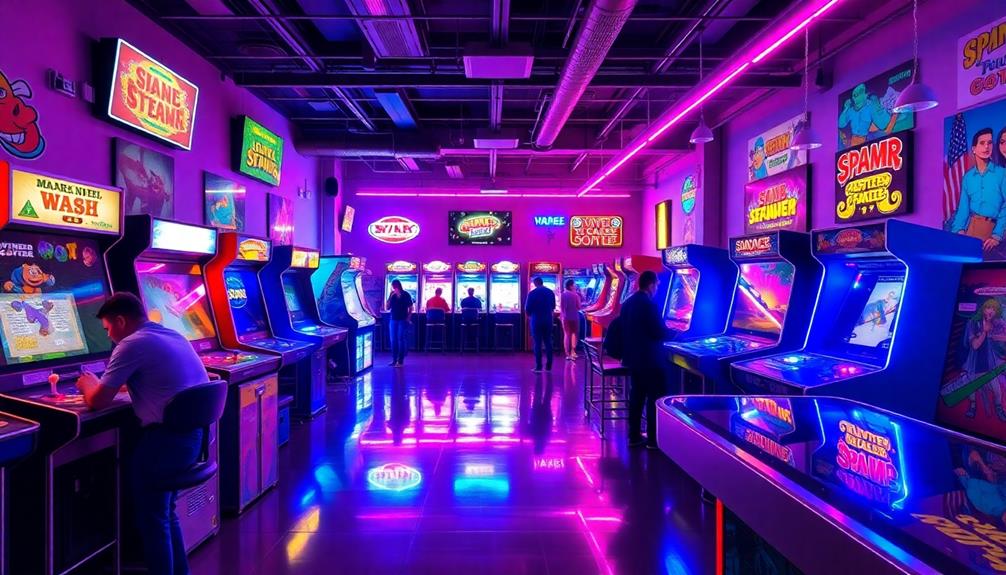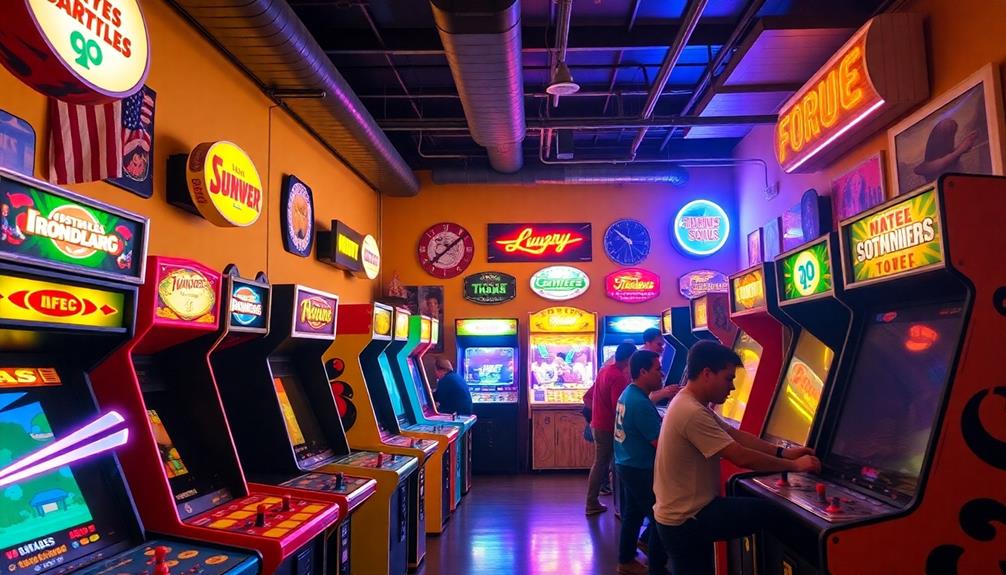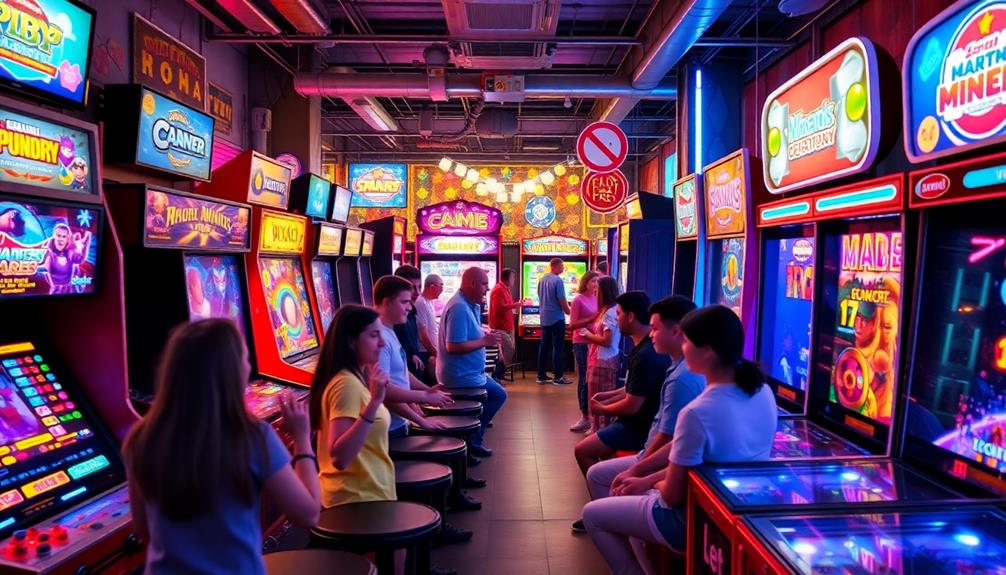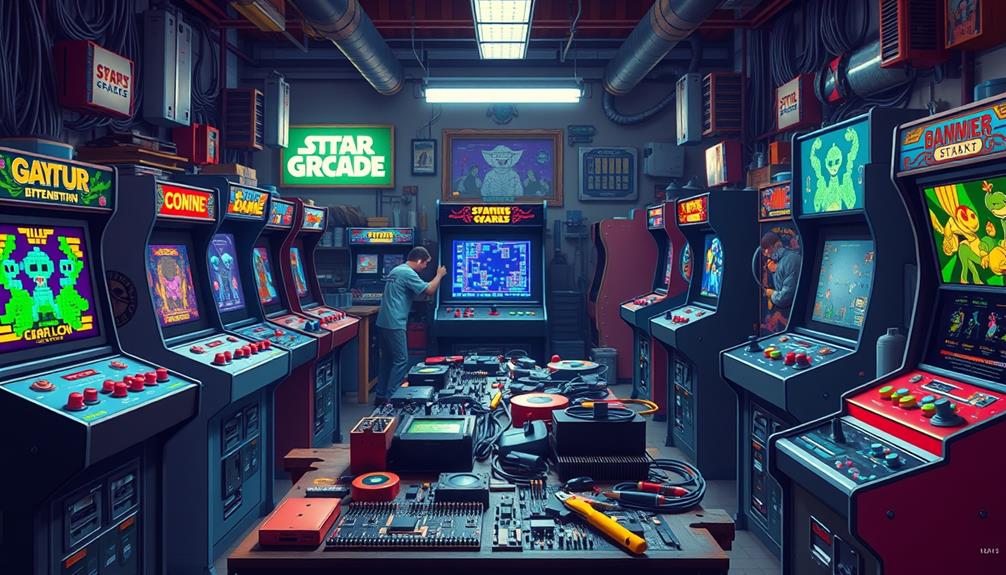Arcade games are machines that require coins to play and are commonly found in public places, designed to provide entertainment. They offer engaging gameplay in a variety of genres, with a focus on skill and timing rather than luck. Well-known classic titles such as “Pong” and “Pac-Man” have made significant contributions to gaming culture. There are also different types of arcade games, including video games, pinball machines, and redemption games that award players with tickets based on their performance. These games have a rich history that has influenced social interactions and competitive gaming. By delving deeper into the world of arcade gaming, you can learn more about its evolution and current trends.
Key Takeaways
- Arcade games are coin-operated machines designed for amusement, found in public venues like arcades and entertainment centers.
- They feature interactive gameplay across various genres, emphasizing skill and timing over chance.
- Classic arcade games include titles like "Pong," "Pac-Man," and "Street Fighter II," which have had significant cultural impact.
- Arcade games range from video games to pinball machines and redemption games that reward players with tickets.
- The evolution of arcade games includes advancements in technology, gameplay mechanics, and social engagement through multiplayer experiences.
Definition of Arcade Games
Arcade games, which are often found in public venues, are coin-operated machines designed for your amusement. These machines offer interactive gameplay across a variety of genres, from fast-paced shooters to engaging puzzles.
The beauty of arcade games lies in their accessibility; they typically feature simple control schemes that anyone can pick up quickly. You don't need to be a gaming expert to enjoy a few rounds. Many modern arcade machines even incorporate advanced technology, blending classic designs with the latest features, making them appealing to both casual and serious gamers in their best arcade machines for home game rooms.
Unlike games of chance, like slot machines, arcade games emphasize skill and timing. They challenge you to hone your dexterity and improve your technique with each play. This focus on skill is what sets them apart; you can actually see your progress.
Classic titles like "Pong," "Pac-Man," and "Street Fighter II" exemplify the appeal of arcade games, having left a lasting impact on gaming culture and design.
The definition of arcade games has remained consistent over the years, even as modern adaptations continue to emerge. They still retain core attributes, such as engaging gameplay and the thrill of competition, making them a timeless choice for entertainment.
Types of Arcade Games
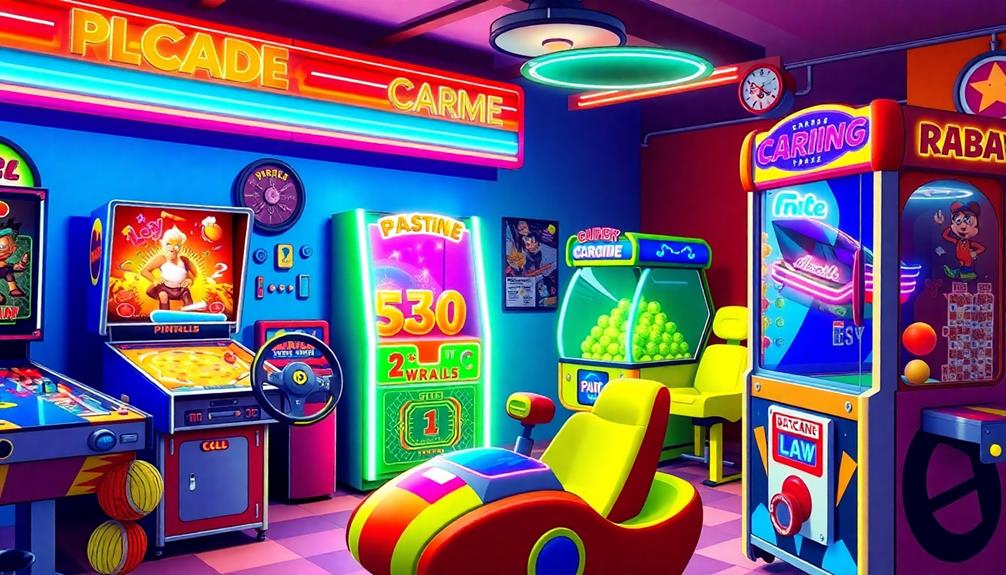
The diverse world of arcade games offers something for everyone, with various types designed to cater to different interests and skill levels. One popular category is video arcade games, which began in the 1970s with classics like Pong. These games typically focus on action and competition, drawing players into immersive experiences. Over time, video arcade games evolved to include advanced graphics, engaging storylines, and multiplayer features, solidifying their place in gaming history. When discussing arcade games vs video games, it’s important to note that while arcade games can include physical activities like skee-ball or air hockey, video arcade games are purely screen-based and rely on digital interaction. Both forms, however, share the common goal of providing entertainment and fostering friendly competition.
As technology has advanced, newer games often feature high-quality graphics and soundtracks, enhancing the overall gameplay experience, reminiscent of the excitement found in best rated pinball machines.
Another exciting type is redemption games. Games like Skee-Ball reward your skills by giving you tickets based on your performance, allowing you to exchange them for prizes. This adds an extra layer of motivation and fun to the arcade experience.
Don't forget about pinball machines, which have evolved from mechanical designs to sophisticated electronic versions. Initially seen as gambling devices, they gained popularity and are now a staple in arcades.
In Japan, pachinko stands out as a unique arcade offering that combines recreation and gambling, featuring mechanical gameplay that captivates players.
While arcade games often include fun diversions like photo booths, it's crucial to note that slot machines typically fall into the gambling category, distancing them from traditional arcade gaming.
Explore these types to find your perfect arcade experience!
Skill vs. Chance
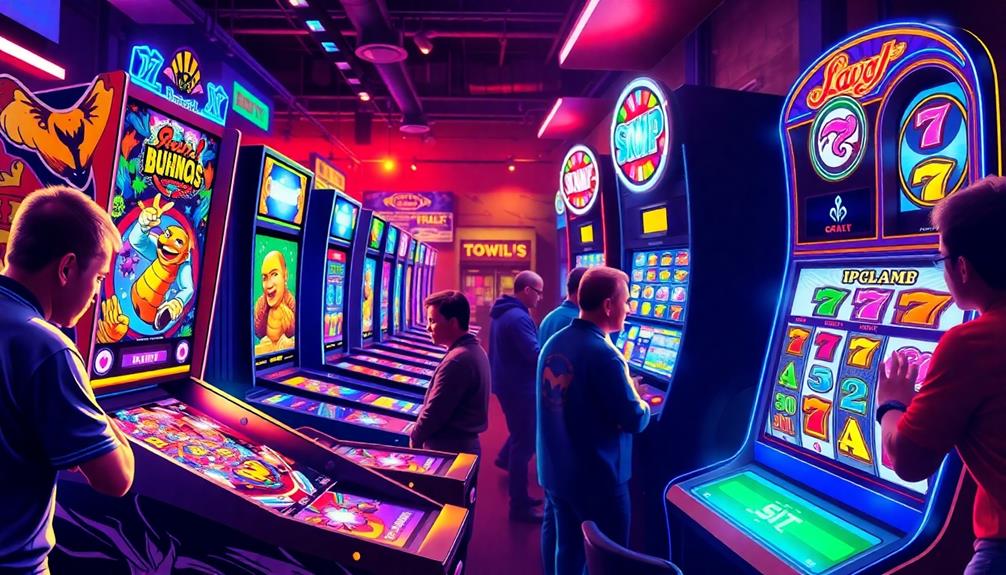
Skill and chance play pivotal roles in the arcade gaming experience, influencing how you approach each game. In arcade games, skill often requires your proficiency and decision-making to achieve success. For instance, games like Skee-Ball reward you with tickets based on your performance, showcasing a blend of skill and chance. The better you aim, the more tickets you earn.
Understanding your investment goals can enhance your strategic approach, similar to how skillful gameplay can lead to greater rewards in arcade settings.
On the other hand, games of chance rely mainly on luck. Take Pachinko, for example. While you can influence your outcomes through skillful play, much of the result hinges on randomness, making it an exciting gamble.
Similarly, pinball machines transformed from mere games of chance into skill-based challenges with the introduction of the electric flipper in 1947, allowing you greater control over the ball's trajectory.
Regulatory frameworks often distinguish between skill and chance games, affecting their legality in different jurisdictions. Games of chance are frequently subject to gambling laws, which can limit their availability.
Understanding the balance of skill and chance in arcade games can enhance your gaming strategy, allowing you to enjoy both the thrill of luck and the satisfaction of mastering your skills.
Historical Overview

Arcade games started as simple amusement park attractions in the 19th century, evolving into the coin-operated machines we recognize today.
You might find it fascinating that the first commercial arcade video game, "Computer Space," paved the way for the gaming revolution with its release in 1971. This early innovation reflects a time when the entertainment industry was beginning to explore new interactive experiences, much like how celebrity transformations have influenced pop culture.
As gameplay mechanics developed, iconic titles like "Pac-Man" not only entertained but also shaped the culture around gaming.
Origins of Arcade Games
Throughout the history of entertainment, countless innovations have shaped the way people play and enjoy games. Arcade games trace their roots back to the 19th century, where they started as simple skill games at amusement parks. By the early 20th century, these games evolved into coin-operated machines, signaling a shift in how players interacted with gaming experiences. The charm and allure of these early games often drew crowds, much like how astrology claims to influence personality traits and attractiveness.
The introduction of pinball machines in 1933 marked a significant milestone, though early versions lacked flippers and were often viewed as games of luck. This changed in 1947 with the invention of flippers, which transformed gameplay.
The mid-20th century saw the rise of electro-mechanical (EM) games, blending electronic and mechanical components to enhance the arcade experience.
In 1971, the arrival of video games like "Computer Space" began a new era, but it was "Pong" in 1972 that truly captured the public's interest. The Golden Age of arcade games emerged from the late 1970s to early 1980s, with iconic titles such as "Space Invaders" and "Pac-Man" solidifying arcade culture as a staple of popular entertainment.
This era set the stage for the vibrant gaming landscape we enjoy today.
Evolution of Gameplay Mechanics
The journey of gameplay mechanics in arcade games reveals a fascinating evolution that reflects technological advancements and changing player preferences.
You start with simple, mechanical coin-operated games in the 19th century. As time progresses, you see the introduction of electro-mechanical games blending electronics with traditional elements. The 1930s marked a pivotal shift thanks to pinball machines, where the 1947 electric flipper transformed them into skill-based challenges.
The Golden Age of arcade games, spanning the late 1970s to early 1980s, brought forth programmable microprocessors. This innovation allowed for iconic titles like "Space Invaders" and "Pac-Man," which captivated players with their complex gameplay mechanics.
By the early 1990s, advanced technologies like 3D graphics emerged, enhancing your gaming experience with titles such as "Virtua Fighter." Today, modern arcade games often feature rapid difficulty escalation, short play sessions, and multiplayer options, blending nostalgia with innovation.
| Era | Key Innovations |
|---|---|
| 19th Century | Mechanical coin-operated games |
| 1930s | Introduction of pinball machines |
| 1970s-1980s (Golden Age) | Programmable microprocessors |
| Early 1990s | 3D graphics and motion simulation |
| Modern Era | Rapid difficulty and multiplayer |
Cultural Significance
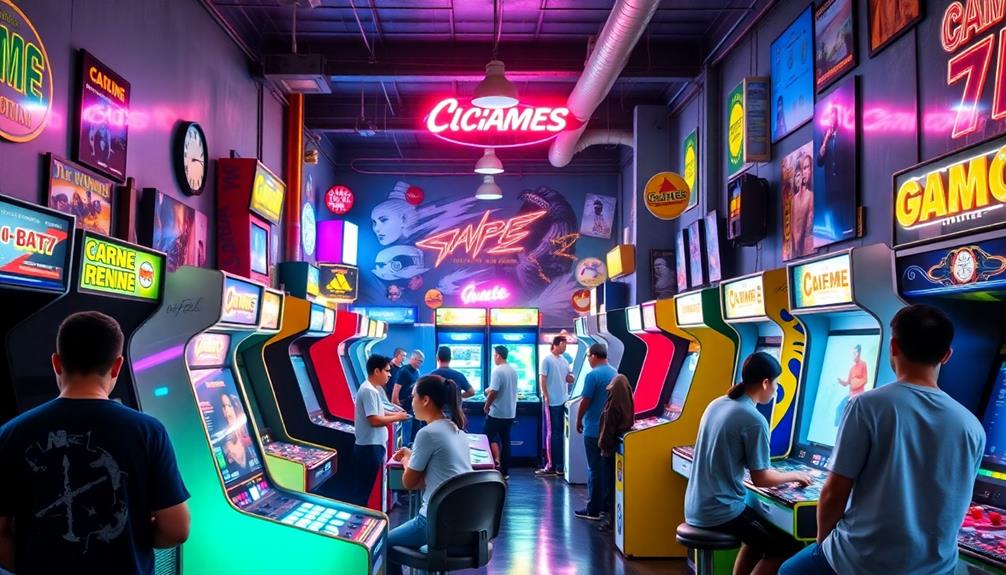
Many people may not realize how deeply arcade games have influenced gaming culture and social interactions. These games paved the way for competitive gaming, creating a vibrant community where players gathered to challenge each other. Iconic titles like "Pac-Man" and "Street Fighter II" didn't just fill arcade rooms; they fostered friendships and rivalries, enhancing cultural engagement among players.
The shared experiences in these gaming environments are reminiscent of the dazzling public appearances of celebrity offspring, which also create a sense of community and connection among fans.
Despite the decline of the arcade industry in Japan—from 26,000 establishments in 1986 to just 4,000 by 2019—the impact of arcade games remains significant. The COVID-19 pandemic further strained this landscape, resulting in the closure of many beloved venues.
Yet, the nostalgic appeal of arcade games continues to resonate today, as many gamers seek out retro experiences and see classic mechanics integrated into modern titles.
As you reflect on your own gaming experiences, consider how these arcade games have shaped not just the games you play, but also the social dynamics that come with them. The legacy of arcade games illustrates their cultural significance, proving that their influence extends far beyond the screen.
Current Trends in Arcades
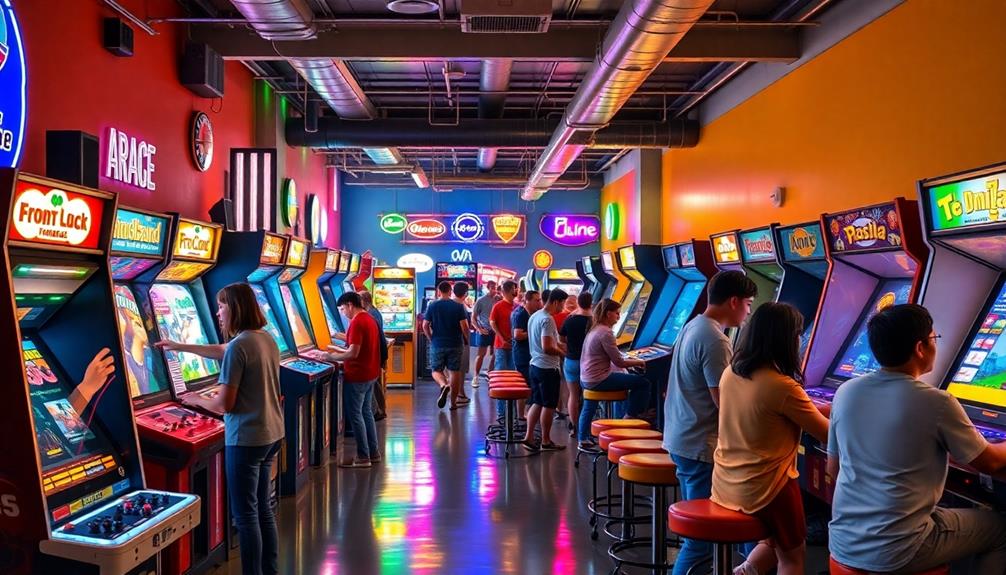
You've probably noticed the resurgence of classic arcade games in remastered formats and retro-themed bars, where nostalgia meets modern fun.
Many of these venues also feature unique attractions like themed water parks, offering visitors a chance to enjoy gaming alongside invigorating activities top hotels with water parks.
Virtual reality is also changing the game, offering you immersive experiences that pull you right into the action.
Plus, arcade bars are becoming the go-to spot for a casual night out, blending gaming with social drinking like never before.
Revival of Classic Games
In recent years, the revival of classic arcade games has taken the gaming world by storm. You might've noticed a surge in retro titles being re-released for modern systems and arcade machines, sparking a nostalgic wave among players.
Arcade bars have become popular hotspots, blending vintage games with social drinking, creating a relaxed environment for older generations while introducing new players to beloved classics. This resurgence is reminiscent of the early days of pinball machines, where the intricate mechanics of pinball captivated audiences and transformed gaming experiences.
Many arcades now boast a mix of classic game cabinets alongside the latest technology, allowing you to enjoy both retro experiences and contemporary gameplay innovations. Events and tournaments for classic games, like Street Fighter II and Pac-Man, have seen increased participation, showcasing the timeless appeal of these iconic titles.
Moreover, the trend of remaking and remastering classic arcade games for mobile platforms has made retro gaming more accessible than ever. Now, you can relive those nostalgic moments on-the-go, expanding the audience for these cherished games.
This revival not only honors the past but also fosters a community that celebrates the joy of arcade gaming, bridging generations and inviting everyone to join in the fun.
Integration of VR Technology
As classic arcade games continue to thrive, a new wave of innovation is sweeping through the gaming landscape: the integration of VR technology.
This shift is transforming how you experience arcade games, providing immersive gaming experiences that engage all your senses. With VR headsets and motion simulators, you can step into virtual worlds that enhance both interaction and realism.
The growth of AI-driven platforms in entertainment is also influencing the development of VR experiences, allowing for more personalized and engaging gameplay options. This trend aligns with the increasing demand for customized experiences in adult content and other entertainment sectors, showcasing the versatility of modern technology AI-generated content.
Here are four key aspects of VR integration in arcades:
- Physical Sensations: VR motion simulators create realistic feedback, making you feel every twist and turn of your in-game actions.
- Increased Foot Traffic: Many venues report up to 50% more visitors, attracted by the novelty of VR gaming experiences.
- Multiplayer Options: Popular VR games encourage social interaction, allowing you to compete or team up with friends, similar to traditional arcade settings.
- Market Growth: The global VR arcade market is projected to reach $1.5 billion by 2025, highlighting the increasing demand for these immersive entertainment experiences.
With VR technology, the future of arcade games looks brighter and more engaging than ever.
Arcade Bars Popularity Rise
Arcade bars are taking the gaming scene by storm, blending the nostalgia of classic arcade games with a lively social atmosphere. These venues are quickly becoming popular social hubs for adults seeking a unique night out. You can enjoy a curated selection of retro arcade games while sipping on a cold drink, making it the perfect combination of fun and relaxation.
The appeal of these spaces is similar to the care considerations for pets, where understanding proper care for pets enhances the overall experience.
The rise of arcade bars is fueled by a growing interest in vintage gaming, with many establishments featuring both classic titles and modern games to cater to all preferences. Events like tournaments and themed nights draw in crowds, providing an interactive experience that traditional bars simply can't match.
Data shows that this trend isn't just a passing fad; many arcade bars report revenue increases of over 20% year-on-year. Urban areas, in particular, have embraced this model, creating vibrant spaces where friends can gather, compete, and socialize.
If you're looking for an enjoyable way to unwind while indulging in some retro gaming nostalgia, visiting an arcade bar is the way to go. It's more than just gaming—it's a social experience that keeps pulling you back for more.
Future of Arcade Gaming
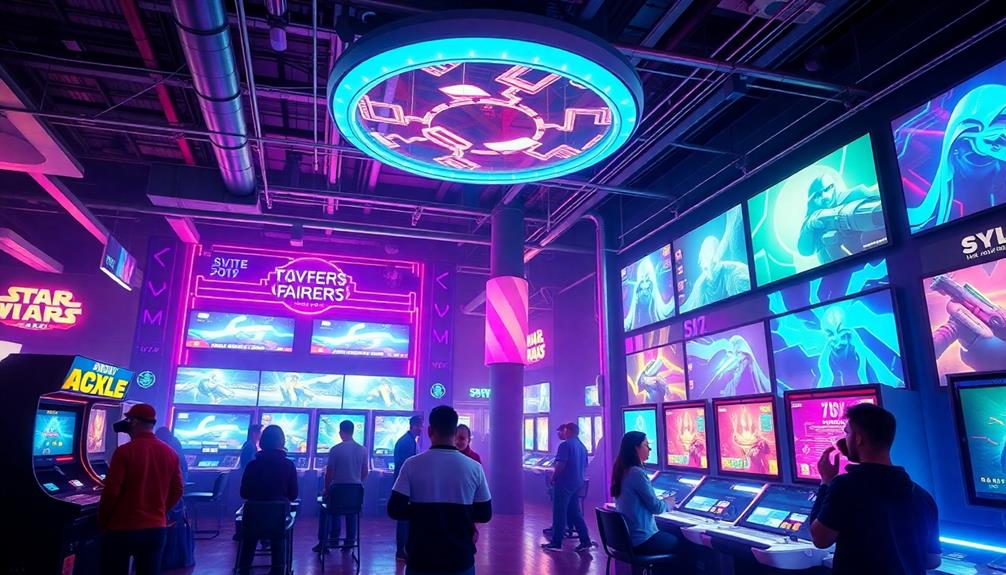
Looking ahead, the future of arcade gaming promises exciting transformations driven by advancements in technology and changing social dynamics.
You can expect to see a fusion of immersive experiences and social interactions that redefine how you play and connect with others. Here are four key trends shaping this future:
- Virtual Reality (VR) Integration: Expect VR experiences to dominate arcades, immersing you in vibrant worlds that go beyond traditional gaming.
- Arcade Bars: These venues will continue to grow, blending gaming with social drinking, making them perfect spots for a casual night out with friends.
- Multiplayer Gameplay: There'll be a strong emphasis on cooperative and competitive multiplayer experiences, encouraging community building and social engagement among players.
- Nostalgic Revivals: Retro games will make a comeback in modern formats, appealing to both seasoned gamers and newcomers alike, creating a bridge between generations.
As arcade operators adapt to post-pandemic realities, hygiene measures and digital gaming options will also become standard, ensuring a safe and inviting space for you to enjoy gaming with friends.
The future looks bright for arcade gaming!
Frequently Asked Questions
What Does It Mean When a Game Is Arcade?
When a game's labeled as arcade, it means it's designed for quick, engaging play with simple controls and fast-paced action. You'll find it challenging yet accessible, often evoking nostalgia from classic gaming experiences.
Is Arcade Game Gambling?
Arcade games can sometimes involve gambling, especially those based on chance, like slot machines. However, many are skill-based, rewarding your abilities rather than luck. It's crucial to check local regulations to understand classifications better.
What Is the Alternate Meaning of Arcade?
When you think of "arcade," you'll find it represents both a covered passageway and a lively entertainment venue. It's a place for shopping, socializing, and enjoying games, blending architecture with modern leisure.
What Does Arcaded Mean in English?
"Arcaded" refers to something designed in the style of an arcade, featuring arches or covered passages. It can describe fast-paced gameplay, nostalgic venues, or environments filled with multiple arcade games for entertainment and social interaction.
Conclusion
To sum up, arcade games are more than just a nostalgic pastime; they're a vibrant blend of skill, chance, and community. As you step into a lively arcade, you're not just playing a game; you're diving into a world where every joystick twist and button press connects you with others who share your passion. With technology evolving, the future of arcade gaming promises to be even more thrilling. So, are you ready to level up your gaming experience?
